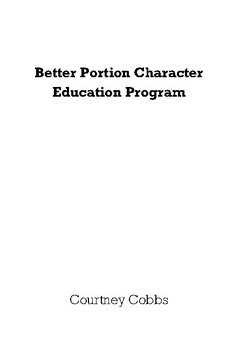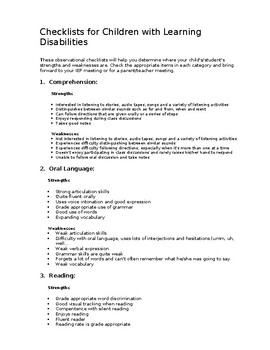14 results
School counseling teacher manuals for Microsoft Word and for homeschool

Better Portion Character Education Curriculum (Elementary-High School)
Looking for a Christian character education curriculum for an entire school including elementary, junior high, and high school? This is the content for you! Herein lies everything you will need for elementary, junior high, and high school Christian Character Education. This is a full, 9-month Christian character education curriculum suitable for private Christian schools, homeschools, co-ops, Christian charter schools, Sunday school classes, etc.This C.H.A.R.A.C.T.E.R. education curriculum conta
Grades:
K - 12th, Staff

Children with Learning Disabilities Checklists:observational checklist(editable)
Checklists for Children with Learning Disabilities These observational checklists will help you determine where your child's/student's strengths and weaknesses are. Check the appropriate items in each category and bring forward to your IEP meeting or for a parent/teacher meeting. It covers the strengths and weaknesses in each of the following:1. Comprehension2. Oral Language3. Reading4. Written Work5. Mathematics6. Motor Skills: 7. Social Skills8.Behavior Skills
Grades:
PreK - 8th, Staff

Positive Behavior Support Planning Booklet
Create a Positive Behavior Support Plan
Download this free template for creating an Individualized Intensive Intervention. This is a step-by-step guide to help you determine the function of the child’s behavior, make a hypothesis about the behavior, and develop a positive behavior support plan, including prevention strategies, replacement skills, and new responses to the behavior. Simply click the menu button on the frame below to download a copy. Share this with your colleagues and please cred
Grades:
PreK - 6th

Choices: a Paradigm for Life, Introducing Need-Driven Behavior, Teacher Manual
Introductory Lesson. Choices: a Paradigm for Life, Introducing Need-Driven Behavior
“Choices” offers an approach to self-management of behavior in seven-six group plans (sold individually or as an entire book). Each group plan includes student learning objectives, a materials list, pre-activity thought provoking questions, and a detailed description of procedures and activities.
“Choices” principles have application to classroom management, behavior management, enhancing student relationships
Grades:
5th - 9th, Staff

Choices: a Paradigm for Life, Lesson 4, Identifying Fun Need, Teacher Manual
Many, if not all, disruptive behaviors are attempts to meet love, power, freedom, and/or fun needs. The needs are legitimate; the behavior is not. When students learn to meet their needs adequately and appropriately, disruptive behaviors will diminish and disappear. This lesson looks at helping students meet their fun need appropriately.
“Choices” teaches that we need fun and defines fun as creative problem solving. All fun is learning, all learning is not necessarily experienced as fun. Depend
Grades:
5th - 12th

"Choices," Lesson 7, Power Need Emotional Indicators, Teacher Manual
Everything we do involves our control need. All inappropriate human behaviors, from childish spats to global wars, are the product of unmet control need—one person trying to control another person, one group trying to control another group. Too often, we react to such behaviors out of our own unmet control need. For we often react to anger with anger. We can only meet our control need by internally controlling our thoughts, choices, and actions and by externally manipulating our environment to m
Grades:
6th - 12th

"Choices," Lesson 9, Emotional Indicators of Fun Need, Teacher Manual
We have a need for fun. Fun plays a major role in the way we want to live our lives. We want to have fun in our work and play, and we develop specific ideas of what is and is not fun. Like the other the dimensions of our lives, we tend to identify and seek fun based on the feelings we receive when we engage in specific activities. We, then, seek out those activities when we want fun, when want the fun feeling. Sometimes we can generate this feeling by the physical movement in which we engage in
Grades:
6th - 12th

"Choices," Lesson 9, Emotional Indicators of Fun Need, Student Workbook
(The purchase of one license allow for thirty copies for the buyer's use.)
We have a need for fun. Fun plays a major role in the way we want to live our lives. We want to have fun in our work and play, and we develop specific ideas of what is and is not fun. Like the other the dimensions of our lives, we tend to identify and seek fun based on the feelings we receive when we engage in specific activities. We, then, seek out those activities when we want fun, when want the fun feeling. Sometimes
Grades:
6th - 12th

Choices, Lesson 5, Identifying Spiritual Need, Teacher Manual
Many, if not all, disruptive behaviors are attempts to meet love, power, freedom, fun, and/or spiritual needs. The needs are legitimate; the behaviors are not. When students learn to meet their needs adequately and appropriately, disruptive behaviors will diminish and disappear. This lesson looks at helping students identify and meet their spiritual need appropriately.
Our spiritual need involves the knowledge of our place in the universe, the affirmation of personal existence, a settled sense
Grades:
6th - 12th

Choices: a Paradigm for Life, Lesson 3, Identifying Freedom Need, Teacher Manual
“Choices” teaches that we need freedom and defines freedom as making the best choice from among available options that contributes to meeting our total need package. Except for reflexes and autonomic bodily functions, we make a choice to do everything we do. We always have options, and we all make choices in everything we think and do.
We derive the name for our program, “Choices,” from the individual’s need for the freedom to make choices to meet his or her needs. Our choices determine our liv
Grades:
5th - 12th

Choices, Lesson 6, Love Need Emotional Indicators, Teacher Manual
“Choices” posits that human essential dimensions include the physical, the mental (psycho-social), and the spiritual. Emotions are functional aspects, indicators of mental needs. “Choices” maintains that all feelings indicate the status of our needs. For the sake of clarity, “Choices” discusses physical sensations, mental emotions, and spiritual affections with regard to feelings in each of these essential dimensions. Since our endocrine and nervous systems produce all our feelings chemically, w
Grades:
6th - 12th

"Choices," Lesson 8, Freedom Need Emotional Indicators, Teacher Manual
Our lives consist of a series of choices. The life we live depends on choices we make. At any given moment, we are the product of all the choices we have made up to that point. Freedom is the capacity to make choices that satisfactorily meet our needs. We have a need for freedom, and we meet our freedom need when make a choice from available options to meet a presenting need. Since we choose all our behaviors, our freedom need comes into play every time we act to meet a need.
Objectives: The s
Grades:
6th - 12th

"Choices" Lesson 10, Emotional Indicators of Spiritual Needs, Teacher Manual
“Choices” sees the individual human as an integrated whole being with physical, mental, and spiritual dimensions. While integrated, these aspects have hierarchal characteristics from physical, to mental, to spiritual. The ultimate spiritual need of humans involves knowledge of one’s place in the universe, the affirmation of personal existence, and a settled sense of being. While many people look to religion to meet their spiritual needs, other people meet their spiritual needs without formal rel
Grades:
6th - 12th

Emotional Indicators of Mental Needs
This paper is a supplement for "Choices: a Paradigm for Life" lessons six through ten. However, anyone interested in behavior and emotions should find it interesting.
“Choices” maintains that feelings are indicators of met and unmet needs. We have physical sensations, mental emotions, and spiritual affections. When the system is running as it should, uncomfortable feelings tell that we have needs to address, and comfortable feelings tell us that we are satisfying our needs. Feelings that relate
Grades:
PreK - 12th, Higher Education, Adult Education, Staff
Showing 1-14 of 14 results

